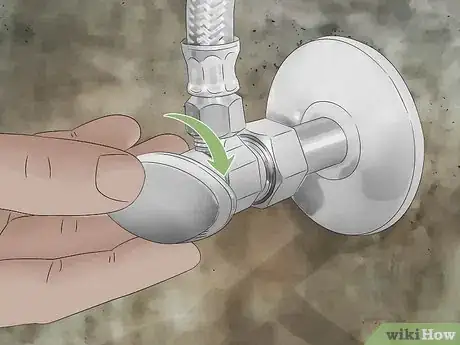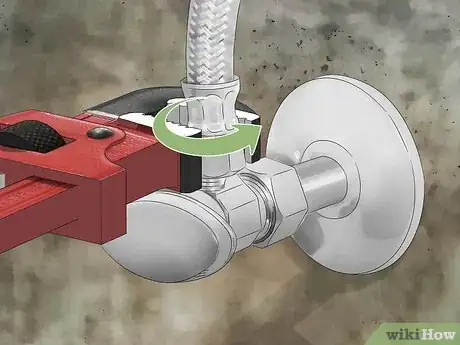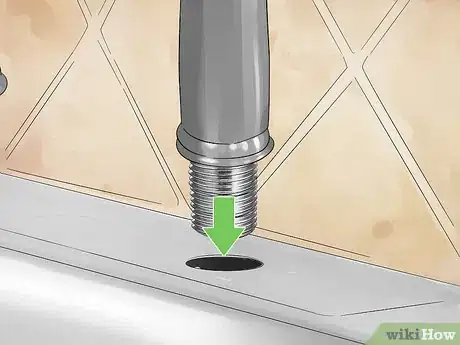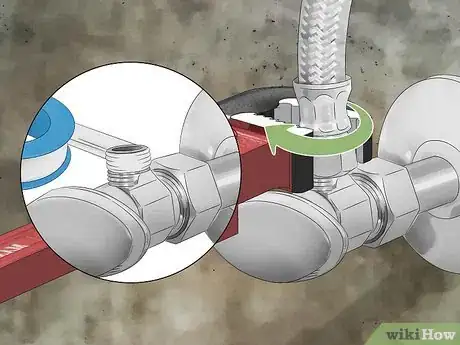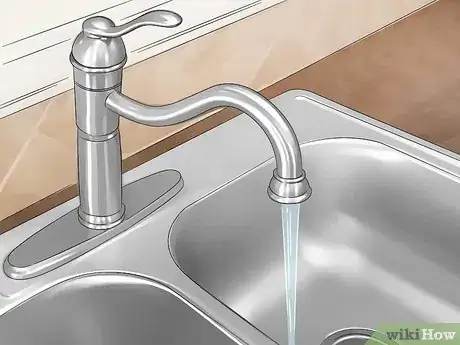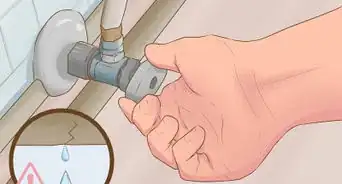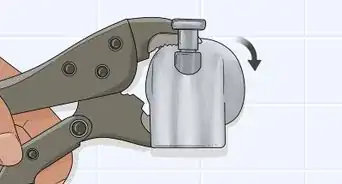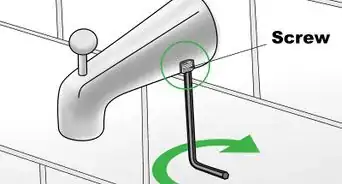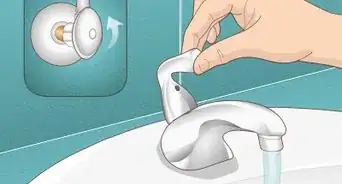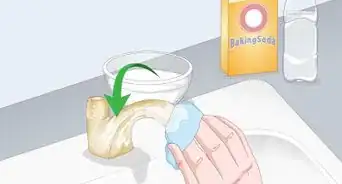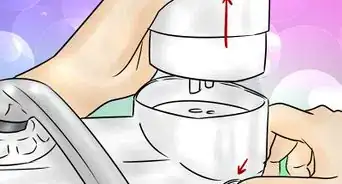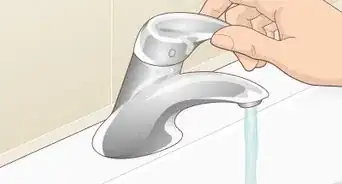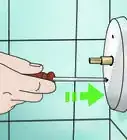This article was co-authored by Patrick Johns. Patrick Johns is a Home Improvement Specialist and the Owner of CatchAll Handyman Services. With more than 28 years of experience, he has worked on a variety of home improvement projects, such as carpentry, plumbing, and door and window installations in both commercial and residential properties.
This article has been viewed 34,152 times.
Whether you're thinking of upgrading your bathroom or kitchen with new fixtures, or replacing an old dripping faucet, knowing how to install a new faucet could save you money. If you've decided to bypass hiring a professional plumber, or you want to develop new skills by learning the basics, get started with Step 1 below.
Steps
-
1Gather the right materials. Special plumber's tools aren't required, just a few basic tools you may already own. Have a small bucket to catch residue water and a plastic drop sheet to keep the bottom of the cabinet dry in case of a leak or spill. Choose a faucet from the hardware store, and follow the manufacturer's instructions. A basin wrench is useful for this; it is used to take out the nut at the bottom that is affixed to the sink. However, standard wrenches or pliers will work just fine. You will also need clear silicone caulk or plumber's putty and some plumber's tape.[1]
-
2Turn off the water. The shut off valves are located below the sink. They are usually oval-shaped and found somewhere below the supply line for the tap. Turn them (very gently) clockwise to shut off the water.[2] If a valve seems excessively tight, it may need to be replaced.[3]
- Check the condition of the supply lines for leaks or obvious wear. You may want to replace these at the same time you replace the faucet.
- Most new faucets come fully assembled, some even with inlet hoses attached. Check with the clerk at the hardware store to be sure.
Advertisement -
3Disconnect the lines. Disconnect the supply lines using a standard wrench. There should be two: one for the hot water and one for the cold.
-
4Remove the nuts. Next, remove the mounting nuts from the bottom of the old faucet. These are usually under the sink and directly below where the faucet meets the counter. There should be between 1-3 nuts and they will usually look less like a traditional nut and more like a target or clock.
- A basin wrench will make this job much easier.
-
5Clean the area. Remove any old caulk or putty around the holes in the sink. This is most easily done with a putty knife. Clean the area thoroughly and wipe dry.[4]
-
6Prepare for the new faucet. Wrap thread seal tape around the threads of the faucet where they connect to the lines. Apply silicone sealant around the sink holes and where the new deck plate will be.[5]
-
7Insert the faucet. Press the faucet down through the sink holes. Align the faucet, using the wall or the back of the sink to keep the faucet straight.[6]
- Once this is done, wipe away any excess residue silicone. Ensure the inside of basin cabinet is dry.
-
8Lock it in place. Hand-tighten the mounting nuts with the thicker side up. Use pliers if necessary to stop leaks, but do not over-tighten.
- It may be handy to follow the specific instructions from the manufacturer for your new faucet, as where and how many of these nuts need to be placed will vary between faucet styles.
-
9Reattach the supply lines with the adjustable wrench. Plumber's tape can also be handy here. Look for a label on the lines attached to the faucet, since you want to connect the correct temperatures (hot handle to hot water, etc).
-
10Test your connections. Turn the water on slowly and check for leaks. If you see any water dripping, turn off the valves and tighten slightly. Repeat if necessary. When everything works the way it should, you're done![7]
Community Q&A
-
QuestionHow do I install a faucet that doesn't have a cutoff valve?
 DonaganTop AnswererYou will have to shut off the main water supply to the building or the line out of the pressure tank if you have one. Then while you're installing the faucet, put in a shutoff valve.
DonaganTop AnswererYou will have to shut off the main water supply to the building or the line out of the pressure tank if you have one. Then while you're installing the faucet, put in a shutoff valve. -
QuestionHow do I flush plumbing lines to clear any debris before starting installation of a faucet?
 Community AnswerAttach the faucet hoses to the piping's stop/shut-off/isolation valves and turn the valves back on while holding the hoses in an empty bucket. Then, turn the valves back off once the water is running clear.
Community AnswerAttach the faucet hoses to the piping's stop/shut-off/isolation valves and turn the valves back on while holding the hoses in an empty bucket. Then, turn the valves back off once the water is running clear. -
QuestionShould I caulk or silicone around a new faucet?
 Community AnswerYou can use a very small amount of silicone if you feel you need it. But faucets come with sealing gaskets or are made with flat bottoms to seal against the counter upon proper tightening. Only silicone if a leak is discovered after installation -- a leak is exceedingly rare.
Community AnswerYou can use a very small amount of silicone if you feel you need it. But faucets come with sealing gaskets or are made with flat bottoms to seal against the counter upon proper tightening. Only silicone if a leak is discovered after installation -- a leak is exceedingly rare.
Warnings
- If the old shut off valves are soldered and need to be replaced, you should contact a plumber, as you may not have the experience or the correct plumber's tools to proceed.⧼thumbs_response⧽
Things You'll Need
- New faucet
- Small bucket
- Plastic drop sheet
- Silicone sealant
- Thread seal tape
- Pliers
- Adjustable wrench
References
- ↑ http://www.planitdiy.com/how-to/plumbing/how-to-replace-a-kitchen-faucet/
- ↑ https://www.hometips.com/repair-fix/water-shutoff-valve.html
- ↑ https://www.familyhandyman.com/plumbing/valves/how-to-replace-a-shutoff-valve/
- ↑ https://www.popularmechanics.com/home/interior-projects/a1448/how-to-remove-caulk/
- ↑ https://www.familyhandyman.com/plumbing/faucet-repair/tips-for-installing-a-faucet-the-easy-way/
- ↑ https://www.thisoldhouse.com/how-to/how-to-install-new-kitchen-faucet
- ↑ https://www.familyhandyman.com/plumbing/faucet-repair/tips-for-installing-a-faucet-the-easy-way/
About This Article
To install a faucet, start by shutting off the water valves under the sink and disconnecting the hot and cold supply lines with a wrench. Then, remove the mounting nuts on the bottom of the old faucet, and take the old faucet off. Next, wrap plumber's tape around the threads on the new faucet, and apply silicone sealant around the sink holes. Finally, insert the new faucet, reattach the mounting nuts to lock it in place, and turn the water back on. To learn how to test your water connections after installing the new faucet, scroll down!

